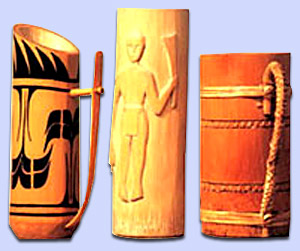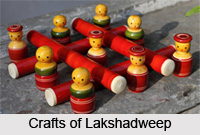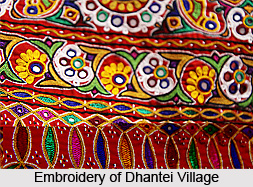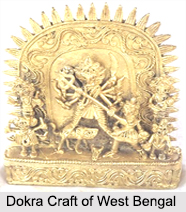 The state of West Bengal with its age old traditional crafts has survived the modernity and industrial production which has admitted huge hindrances in the growth of arts and crafts. The skilled artisans of the state have moulded their craftwork accordingly with the contemporary times and have showcased their expertise in the art of survival as well. The designs made by the craftsmen are often particular to a specific region and some pieces even carry the imprint of outside influences, be it ancient or modern. Listed below are some of the famous crafts of West Bengal.
The state of West Bengal with its age old traditional crafts has survived the modernity and industrial production which has admitted huge hindrances in the growth of arts and crafts. The skilled artisans of the state have moulded their craftwork accordingly with the contemporary times and have showcased their expertise in the art of survival as well. The designs made by the craftsmen are often particular to a specific region and some pieces even carry the imprint of outside influences, be it ancient or modern. Listed below are some of the famous crafts of West Bengal.
Dokra: The dokra craft is characterized by its primitive simplicity, charming folk motifs, rustic beauty and imaginative designs and patterns. The process of dokra metal casting is done by using an earliest method of non-ferrous metal casting known as the "lost wax casting". This technique was used by a tribe called Dokara Kamar Tribe, who are known to be the original metal-smiths of Bengal. The people of the tribe have now dispersed in the western part of the state in the 4 districts of Bankura, Purulia, Midnapore and Burdwan. Currently, the dokra artefacts range from figurines, deities, elephant, owl, deer and other animals to ornaments like anklet, ankle bells, earring, necklace and bangles. They also make utility items like nut cracker, kohl holder, vermillion holder, utensils etc.
Brass and Bell Metal: Utensils and artefacts made of brass and bell metal has been an old handicraft product of West Bengal since the early 18th century. The traditional brass artisans made handcrafted metal wares and artefacts from scrap metals. Artisans of Bankura, Bishnupur, Ghatal and Chandanpur in Midnapore, are engaged in engraved brass and bell metal work.
Pottery: Found in all corners of the state, the art form of pottery is available in several types. The potters make the best use of the clay that is found on the banks of rivers that cut through the state. The clay is then moulded into different shapes and sizes for items used for various purposes. The main items made are the images of deities, clay pots and plates.
The art form of terracotta is a part of this. Bankura"s terracotta is an internationally appreciated art form, for its pastoral and rustic charm. In the 16th to 17th century, during the reign of the Malla rulers, terracotta art were quite famous. It is believed that the tradition of making terracotta craft items started from the Panchmura region. The artists then used to inscribe the temple walls with the artwork. The temple of Bishnupur stands as a marvellous example of the terracotta craft in Bengal. Another form of craft is the ceramic craftsmanship which was influenced by the craftsmen of British and other foreign artisans. Ceramic crafts are famous mostly in the Birbhum district of West Bengal.
Clay Craft: West Bengal has an ancient heritage of dolls; the Ghurni area of the Nadia district is very popular for making the clay idols. The major factor for real-life stylized clay dolls were first made in the late 18th century under the patronage of Maharaja Krishnachandra of Krishnagar. Dolls made by women from the potter communities are of soft clay and fried clay which are available all over the state.
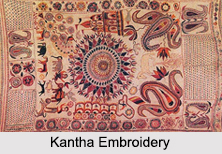 Kantha Embroidery: It is the type of stitching in which decorative images on clothes are outlined with colourful threads and running stitches. This stitch is used for designing saris, ethnic-wear, dhotis, bed-linen, cushion covers, quilts and more. The Kantha Stitch is one of the most popular handicrafts of Santiniketan in the Birbhum district of West Bengal.
Kantha Embroidery: It is the type of stitching in which decorative images on clothes are outlined with colourful threads and running stitches. This stitch is used for designing saris, ethnic-wear, dhotis, bed-linen, cushion covers, quilts and more. The Kantha Stitch is one of the most popular handicrafts of Santiniketan in the Birbhum district of West Bengal.
Conch Shell Craft: This craft is actually an art of engraving decorative motifs on the natural shells obtained from the ocean. The beautiful crafting and delicate work makes it a popular item of decoration. Apart from this it is being considered as extremely auspicious in the Hindu mythology which heightens its demand among people. The conch shell crafts of west Bengal are not only beautiful and delicate pieces of art; they are also traditionally worn as bangles by the married Bengali women.
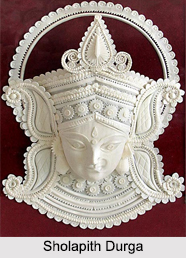 Sholapith Craft: Sholapith which is also referred to as shola and Indian cork, is a milky-white weight sponge-wood which is carved into delicate and beautiful objects of art. The shola plant grows in the marshy waterlogged areas of West Bengal, Assam and in the eastern marshy Gangetic plains. Artisans use it to make artefacts used for decoration, especially the traditional ornate headgear of bridegroom in Bengal. The finest of this craftsmanship can be seen on the statues of Gods and Goddesses during festivals, especially the massive decorative backdrop used for the Durga Puja. The craft is mainly practised in the districts of Burdwan, Murshidabad, Birbhum, Nadia and Hooghly. The people engaged as sholapith craftsmen are known as Malakars, meaning garland makers.
Sholapith Craft: Sholapith which is also referred to as shola and Indian cork, is a milky-white weight sponge-wood which is carved into delicate and beautiful objects of art. The shola plant grows in the marshy waterlogged areas of West Bengal, Assam and in the eastern marshy Gangetic plains. Artisans use it to make artefacts used for decoration, especially the traditional ornate headgear of bridegroom in Bengal. The finest of this craftsmanship can be seen on the statues of Gods and Goddesses during festivals, especially the massive decorative backdrop used for the Durga Puja. The craft is mainly practised in the districts of Burdwan, Murshidabad, Birbhum, Nadia and Hooghly. The people engaged as sholapith craftsmen are known as Malakars, meaning garland makers.
Wooden Craft: The art of making wooden dolls have been an age old practise in the state of West Bengal and the village of Natungram. Wooden dolls like Gouranga, Krishna, Bor-Bou, Gour-Nitai, owl, etc. are made in this village. Traditional tribal masks are made of wood, which are now often times used in religious festivals and have great demand in contemporary times as a decorative item in the household. The famous Darjeeling masks are made of soft wood and then painted over usually represent demons and evil spirits. These masks are also used in dances in the hilly areas.
Bamboo Craft: Bamboo along-with cane are two very useful forest product found in most Bengali households. Various types of handicraft products including woven or assembled baskets, decorative trays, lamp-sheds, tea-tables, screens and hangings, etc are made from cane and bamboo, which is widely used in the country and even abroad. West Bengal has its very own tradition in creating every day fancy articles from bamboo and cane which is rich and varied.
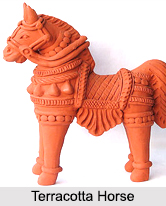 Weaving: It is an age-old craft of West Bengal. The craftsmen deftly weave cotton to make threads, which are later woven in to the marvellous tant sarees, which are worn by Bengali women. The tant sarees have a distinct appeal and have a relatively good market not only in other parts of India but abroad as well. The tant sarees of Phulia, Shantipur and Dhaniakhali are famous and have a huge market. The Baluchari sarees, which originated in the district of Murshidabad is another variety of saree for which Bengal is famous. Baluchari sarees have seventeen colours in it with "butis" sprinkled all over. It is a plain-woven fabric brocaded with untwisted silk thread with distinctive designs. The pallu is decorated with diverse designs ranging from scenes from the Mahabharata and Ramayana, and historical monuments. The sarees are usually in dark shades like red, purple and chocolate colours. A simple Baluchari has small dots or flowers all over the saree and a flowery border in the pallu.
Weaving: It is an age-old craft of West Bengal. The craftsmen deftly weave cotton to make threads, which are later woven in to the marvellous tant sarees, which are worn by Bengali women. The tant sarees have a distinct appeal and have a relatively good market not only in other parts of India but abroad as well. The tant sarees of Phulia, Shantipur and Dhaniakhali are famous and have a huge market. The Baluchari sarees, which originated in the district of Murshidabad is another variety of saree for which Bengal is famous. Baluchari sarees have seventeen colours in it with "butis" sprinkled all over. It is a plain-woven fabric brocaded with untwisted silk thread with distinctive designs. The pallu is decorated with diverse designs ranging from scenes from the Mahabharata and Ramayana, and historical monuments. The sarees are usually in dark shades like red, purple and chocolate colours. A simple Baluchari has small dots or flowers all over the saree and a flowery border in the pallu.
Jute Craft: Jute, the `golden fibre` has traditionally been woven and knotted and braided by women of Bengal, often for domestic storage. Jute as a fabric was much popular in ancient times. Today Bengal is not only a major producer of jute goods ranging from plush jute-blended carpets but also decorative tapestries, garden pot hangings, decorative hand bags, bedspreads and more.
Scroll Painting: The craft of scroll painting is a tradition in West Bengal and the painters are known as patidars. On a long piece of cloth, black earth mixed with cow dung is laid. When the cloth dries, a coating of lac is given to harden it and fill up the porous surface. The outlines of the figures are in black or red and the inside part is filled with vegetable dyes which retain their brilliance over a long period. The icons are bold and unstructured in style.



